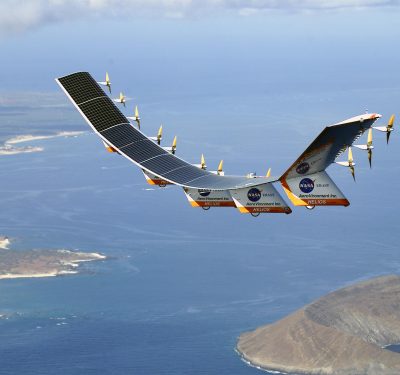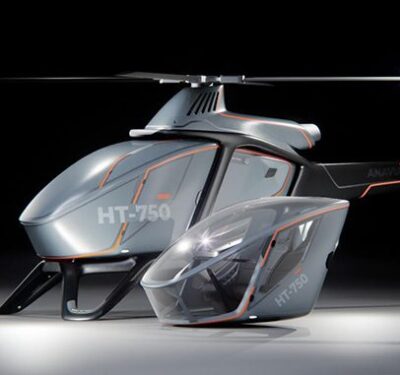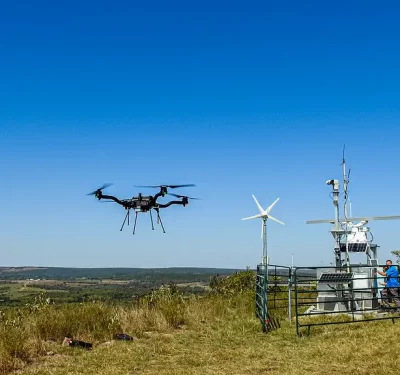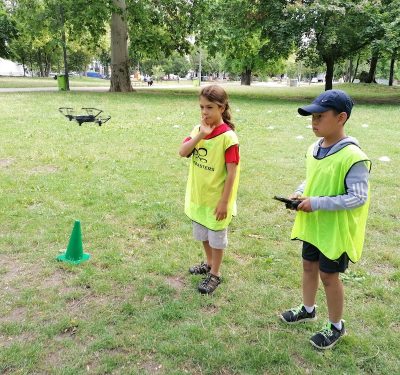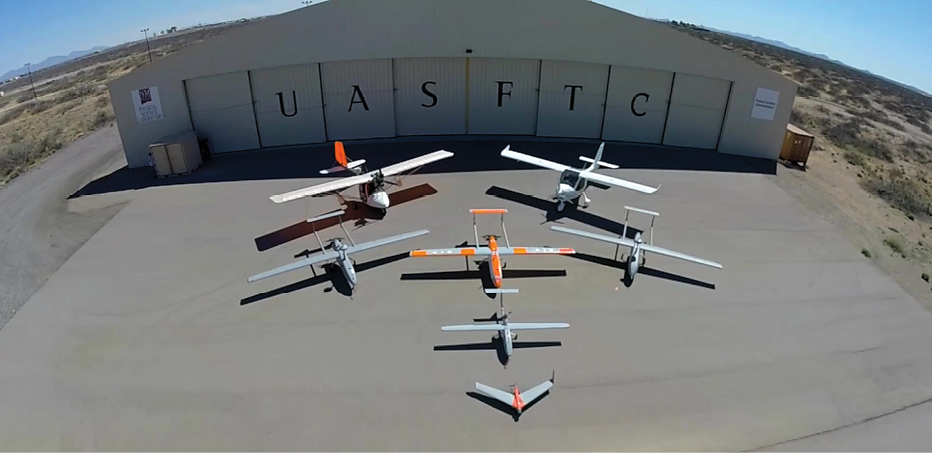
The New Mexico State University Unmanned Aircraft Systems Flight Test Center offers 7,500 feet of paved runway and eight operating airfields.
As unmanned aircraft have evolved, the New Mexico State University Unmanned Aircraft Systems Flight Test Center has been there, providing guidance and a top-notch space for researchers and manufacturers to test Unmanned Aircraft Systems (UAS) of all sizes and capabilities.
The center, part of the university’s Physical Science Laboratory, became the first Federal Aviation Administration approved test site in 2007, and since then has conducted countless research flights for both military and civil applications said Dallas Brooks, the center’s director of UAS development. They’ve also completed a variety of “first evers,” including flying under the first emergency Certificate of Waiver or Authorization (COA) for fire support in 2004 and the first live-fly integration of an FAA-certified Flight Management System (FMS) into a UAS control system in 2010-2011.
The center features a 15,000 square foot hangar and a 7,500 foot paved runway, along with eight operating airfields. Located in Las Cruces New Mexico, the team first began performing UAS test flights in the 1990s, and has nearly 20 years of experience.
The team owns a number of unmanned aircraft, more commonly called drones, that they operate on behalf of their customers to test new technologies. And they don’t just test the UAS themselves—they also test the subsystems and components that make them work. On any given day at the Flight Center researchers might perform integration testing to see how well different systems work together, or conduct air worthiness assessments for new aircraft or older aircraft flown in new configurations. They’re also the only test site that has access to restricted airspace.
“We have more experience at NMSU than any of the other test sites combined, and we operate out of a mixed-use airport. We launch UAS side-by-side with manned aircraft every day,” Brooks said. “And we have direct access to FAA restricted airspace. We can test higher-risk aircraft and scenarios without any risk to the masses.”
The ASSURE Team
Recently, the New Mexico test site joined the ASSURE team, that is the Alliance for System Safety of UAS through Research Excellence, the group chosen in May to manage the FAA’s new Center of Excellence (CoE) for UAS Research. The CoE will begin projects to support their mission in October—and Brooks said he is proud to be part of the team selected for this pioneering effort.
While the FAA has many other centers of excellence, this is the first UAS-specific center. Brooks said he expects this team to raise the bar, not only helping as the FAA works to integrate UAS into the national airspace but, providing new standards for other test centers to strive for.
“We’ve really started with a bang, and I don’t expect the pace to slow down at all,” Brooks said. “The FAA has been engaged and supportive. The conversations have quickly drilled down to key topics that need to be addressed. Folks on both sides are ready to get to work.”
NMSU researchers already have plans to start on two projects later this year, and will be working with other ASSURE team members along the way. One of those areas is detect and avoid, Brooks said, and the other the impact of the flight environment on the human pilot.
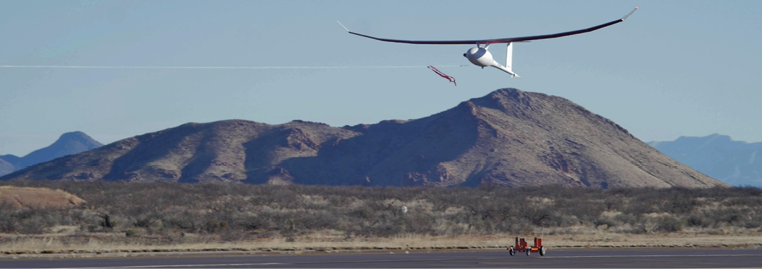
Vanilla Aircraft’s VA001 launch
The Human Factor
The center, led by Dr. Igor Dolgov, assistant professor in the New Mexico State University Psychology Department, recently conducted field studies to look at whether low-altitude, night-time flights with small UAS are as safe as those done during the day. During that NASA-funded research they found some encouraging results: night operations are just as safe as day operations, if not safer.
They looked at different UAS platforms to determine how well operators could not only track the small UAS during the day, at night and at dusk, but also at how good the operators were at avoiding collisions with an intruder manned aircraft. They used the Raven, Wasp and Puma for the testing, all from AeroVironment. Testing was performed in the desert. To determine how city light pollution affected the observers, they brought in artificial lights to simulate an urban area for the second phase of the research.
“The light pollution didn’t impact visual observation as much as people thought it would,” said Dolgov, who serves as the human factors lead in visual operations for the Center of Excellence. “They did just as well with the light pollution as they did without it, and just as well as they performed during the day.”
The recovery lights UAS use to land helped night observers keep better track of the systems in the dark, and also enabled them to better predict collisions—though this is the area observers struggled with most. To help, the researchers introduced “rings of safety”: an air traffic alert zone, a resolution advisory zone and a mid-air collision zone.
“They had to estimate if the aircraft was going to enter the near mid-air collision zone, provide the time to the collision as well as instructions for the safest path out of there for the UAS,” Dolgov said. “The UAS always stayed on its flight path. The intruder was always separated in vertical space from the UAS. There was never any real danger of a collision.”
Dolgov and other members of the ASSURE team will continue this research with a project set to start in October. They’ll conduct an ethnographic study of small UAS observers, visual operation training instructors and small UAS pilots. During this study they’ll immerse themselves in this group’s culture and communities to see how they function.
The research will break important new ground, Dolgov said. When small UAS observers and pilots have been studied before, it’s been through contrived scenarios. While that information is valuable, it doesn’t give enough insight into what trainers and operators have to know to perform their jobs, and that’s the information the FAA needs before it can finalize regulations.
“Our goal is to go to different sites and talk to folks who have been going through the training and determine what skills are essential for visual observers to have before they’re certified by the FAA,” Dolgov explained.
Once that part of the two-year project is complete, they’ll use the rest of the time to perform validation and verification testing with visual observers from the New Mexico test site.
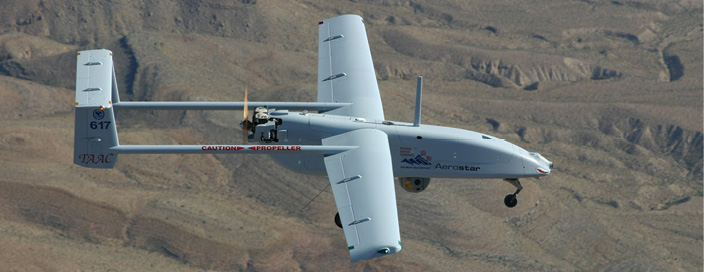
Aerostar A UAS
Detect and Avoid
The detect and avoid task for ASSURE will support the development of an operational framework for small UAS flights at low altitude, Brooks said, which would make it possible for these UAS to fly beyond visual line of sight. They’ll look at environmental factors to determine which conditions detect and avoid systems work best in.
“Beyond visual line of sight has challenges because you have to demonstrate a clear capability of the aircraft to detect and avoid other aircraft when it’s outside of the pilot’s visual range,” Brooks said. “Rather than having a pilot looking out the window, you have electronic systems scanning the sky around the aircraft to detect other aircraft or other obstacles, and identifying the potential for collisions and maneuvering the aircraft so that doesn’t happen.”
Once they develop that framework, they’ll do a comparison of approaches that evaluate detect and avoid technology, Brooks said. They’ll test various options, including placing the sensors on the ground or on the actual aircraft. There are also multiple sub categories to consider, including cooperative and non-cooperative UAS and other potential obstacles. Cooperative obstacles have transponders or radios that can notify other aircraft of their location, while non-cooperative objects and aircraft do not.
By the end of the research, they hope to provide recommendations for the system performance levels and the environments necessary to ensure their success.
“There are various configurations that combine two technologies to prove the best coverage and the best performance,” Brooks said. “We’ll look at component technology as well. What sensors work best in what environment, what advanced algorithms work best. We have to look at the size, weight and power of the various options mounted on the aircraft. Small UAS are limited in what they can carry. We need efficient solutions for detect and avoid.”
The Future
Through these two research projects, the New Mexico Test site is helping the Center of Excellence answer two very important questions—how to safely fly UAS at night and how to fly beyond visual line of sight.
“This research will really inform and help the FAA come up with criteria defining a safety base for night operations. It will help de-mystify some of those areas in terms of what night operations actually entail,” Dolgov said of his research. “Extending the operation zone for unmanned aircraft along with overcoming the night restrictions opens up the possibilities for civil and commercial operations.”
UAS have been a must-have for warfighters for years, Brooks said, and the advantages they offer the military can enable a variety of commercial applications, from helping with disaster relief efforts to supporting those fighting wildfires to farming using precision techniques. The work the New Mexico test site has done and will continue to do through the Center of Excellence will keep this technology evolving, and help make UAS safer to operate in the national airspace.
“Unmanned will touch everything. That includes ground apps, maritime and space apps. It’s not just aviation. That’s where we see the impact most clearly because right now there’s so much focus on air,” Brooks said. “Pervasive is the word I would use. We’re going to see unmanned technology ingrained into everything.”


